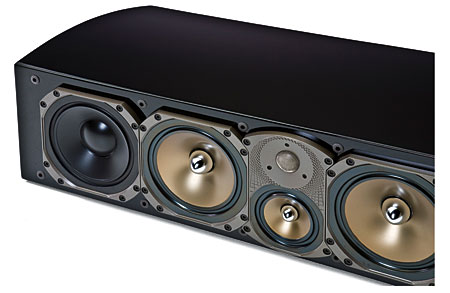Paradigm Reference Signature S8 Speaker System Page 2

Performance
Since I had such an amazing first impression of the Signature line, I wondered if they would live up to my high expectations. I also wondered how much difference I would detect in performance now that they had a new tweeter. I positioned the main speakers about 3 to 4 feet from my front and side walls, which gave them plenty of breathing room. I started with the speakers positioned in a perfect equilateral triangle, but I eventually moved the S8s in just a touch and toed them in slightly. This gave me the best balance of low-bass performance and imaging.
Without a doubt, the S8’s most captivating quality is its upper end. The new tweeter sounded effortless at any volume I tried. I like to play my music loud, and when you have a large room to fill, speakers tend to fumble in the upper end and cause fatigue and strain. I auditioned a number of concert videos, including selections from the Eagles, Diana Krall, and my personal favorite, Nine Inch Nails. The latter provided a system-threatening level of dynamics on Blu-ray. The speakers I used before the S8s had a hard time keeping up with this release at near-reference levels in my theater room. The S8s didn’t sound the least bit taxed, although my ears (and wife) started to complain.
With Diana Krall in the mix, I was impressed by the S8’s low end. The standup bass never sounded bloated, while plucked notes were tight and provided a great balance of body without sounding loose.
The C5 is one of the best centers I’ve used for its ability to disappear. I set up the C5 on the matching floor stand below my screen, about 3 feet forward from the front wall. The C5’s voicing blended seamlessly with the flanking S8s. It created an extremely cohesive soundstage with no change in timbre during pans across the main soundstage. I’m always a bit skeptical of center channels with tweeters that are located considerably higher or lower than the main speakers. However, the C5 imaged beautifully within the vertical soundstage.

Movie dialogue seemed to float effortlessly above the C5, and it anchored perfectly with the image. This sensation of vertical sonic imaging became even more evident with multichannel music. I used a wide assortment of DVD-Audio content to test the main soundstage, and I never had an issue with imaging or tonal balance.
The ADP3 provided a wide soundfield and lived up to its promise of non-localization. This was incredibly apparent with the Blu-ray release of Master and Commander: The Far Side of the World. The movie has an incredibly engrossing soundtrack that images better than just about anything I’ve heard. The soundfield is seamless from front to back and even overhead, which is a rarity in my experience. The ADP3s did a sensational job creating a realistic surround soundfield, whether it was reproducing discrete sounds or just the sense of enveloping ambience.
I was somewhat worried about how a dipole design would do with multichannel music selections. I’ve used matched surrounds for quite a few years now, and I love how perfectly they blend with the mains as music pans from front to back. Although the ADP3s gave up some of that pinpoint imaging, they still did a great job creating an engulfing soundfield. With 5.1-channel music recorded with an audience mix that puts you in the crowd, they actually did better than my matched surrounds. The sense of environment that the ADP3s provided was staggering. There was just a better sense of atmosphere and space.
Since the ADP3s strive for an open soundfield, music with a stage mix sounded a bit too diffuse. It didn’t distract me as much as I thought it would, but choir recordings just didn’t have the same effect as they do with a direct-radiating matched speaker. But given the ADP3’s performance with movie soundtracks and concert performances, I would be more than happy to give up that last degree of imaging precision.
Conclusion
As a cohesive unit, the Signature setup was second to nothing I’m familiar with. The experience I had with this setup was just as impressive as my experience a few years ago. The Signatures rendered the most demanding 5.1 mixes with no signs of fatigue at all—even at reference levels. They deliver dynamics with aplomb, and the seamless imaging from speaker to speaker is a testament to their design.
It’s always a lot of fun to see what a world-class speaker manufacturer can deliver when it sets out to create a flagship design. The Signature series is the real deal. It sounds effortless at any playback level and provides breathtaking imaging and incredible dynamics. I’ve found my new reference.

- Log in or register to post comments



























































